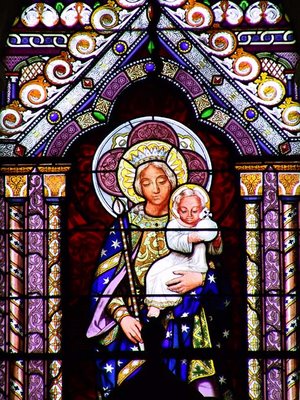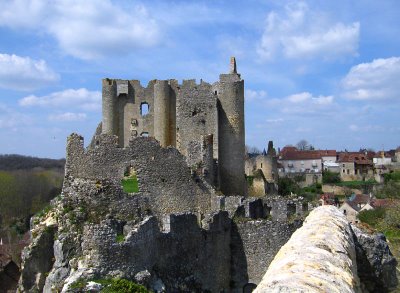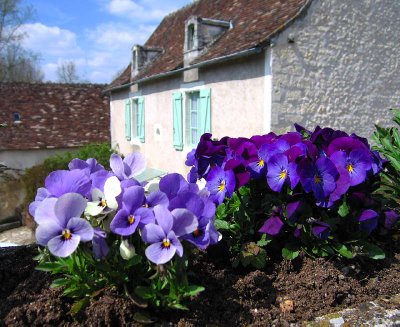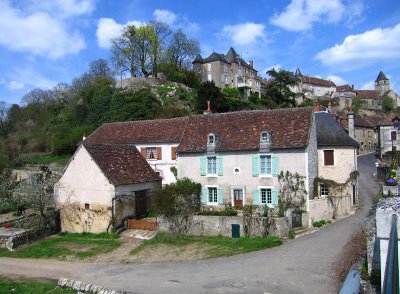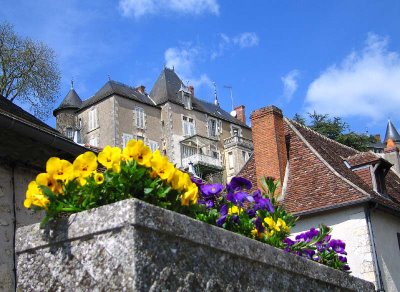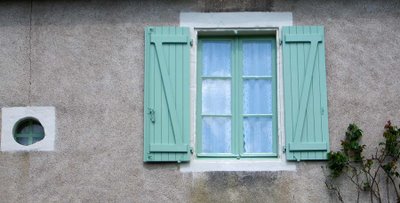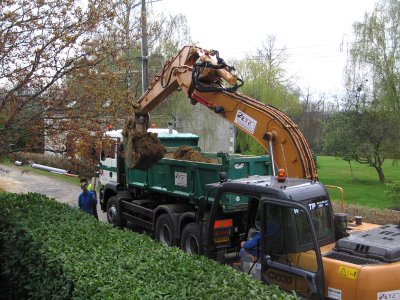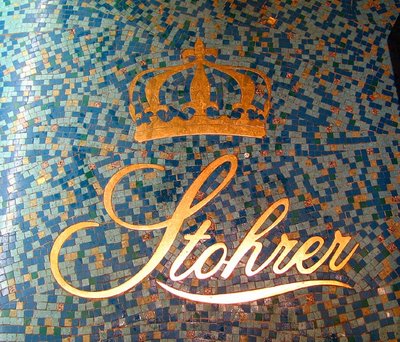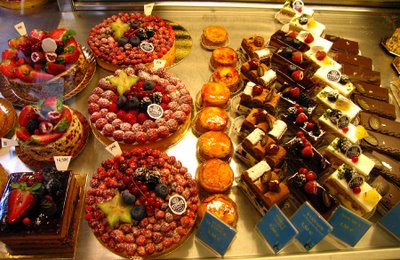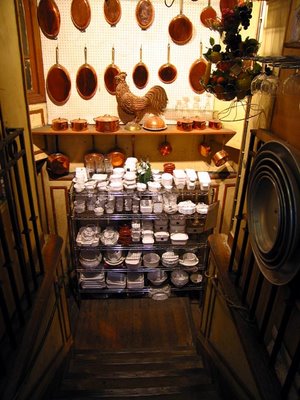Friends of ours from California who recently bought a house near St-Aignan were here last week, and other friends were here this week. It has been busy. I haven't had time to do much blogging, and that is not going to change much over the next few days.
I've been to the town of Loches two or three times this month, and I can't say enough good things about it. The shopping district is pleasant and busy. The surrounding area is beautiful. The medieval district, with a royal palace and an old fortified château, is fascinating.
Here are a few pictures I took in Loches on Tuesday.
More next week...
27 April 2006
24 April 2006
A pâtisserie in Loches
Last week we were in the town of Loches to help our friends get a phone line up and running at their new house, and to do some shopping at the big Centre Leclerc hypermarket there. We had lunch in the old town in a nice restaurant but we decided not to have dessert. We were being sage -- behaving ourselves and watching calories and all that.
Then we walked by this pâtisserie. Temptation got the best of us. I don't think anyone would blame us for buying a few pastries to eat as a late afternoon snack when we got back to the house.

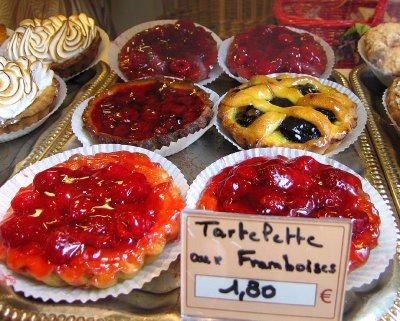
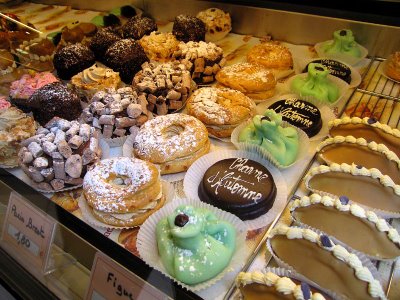 Shops with pastries like these are to be found in every town and many villages across France.
Shops with pastries like these are to be found in every town and many villages across France.


 Shops with pastries like these are to be found in every town and many villages across France.
Shops with pastries like these are to be found in every town and many villages across France.
22 April 2006
Angles-sur-l'Anglin
Angles-sur-l'Anglin is a small village that is officially in the Poitou province. It's located about 50 kilometres east of the provincial capital, Poitiers, and about 75 kilometres south of Tours. It's just over the ancient border that separates Le Poitou from the south end of La Touraine. And it's about an hour's drive south of Saint-Aignan, where I live.
The names of the village (Angles) and the river that runs through it (l'Anglin) derive from a group of Angles who supposedly settled the place between the years 500 and 1000 A.D., according to different sources. The Angles were a Germanic people who, along with the Saxons, also settled in what is now England.
A rocky path and some rough stone steps lead you up to the top of the outcropping that the château was built on. The view is impressive and the ruins are strikingly stark. The village itself is one of the 150 or so to be designated one of the most beautiful in France.
Other beautiful towns near Angles are La Roche-Posay, Preuilly-sur-Claise, and Le Grand Pressigny. Visiting them all, with stops of an hour or so in each, makes for a good day trip. Another sight to see near Angles is the abbey at Fontgombault, where there is a pottery shop with dishes and pots made by the monks on sale.
Here's a site in French with other pictures, including an aerial photo of the village and its château. Archeological evidence shows that the area around Angles-sur-l'Anglin has been inhabited since prehistoric times, as far back as 14,000 years ago. Records also show that the château at Angles existed as early as the year 1026 A.D. During the French Revolution at the end of the 1700s, the ruins of the château, like many other historic sites, were turned into a quarry where people could get the stones they needed to build their houses.
The names of the village (Angles) and the river that runs through it (l'Anglin) derive from a group of Angles who supposedly settled the place between the years 500 and 1000 A.D., according to different sources. The Angles were a Germanic people who, along with the Saxons, also settled in what is now England.
A rocky path and some rough stone steps lead you up to the top of the outcropping that the château was built on. The view is impressive and the ruins are strikingly stark. The village itself is one of the 150 or so to be designated one of the most beautiful in France.
Other beautiful towns near Angles are La Roche-Posay, Preuilly-sur-Claise, and Le Grand Pressigny. Visiting them all, with stops of an hour or so in each, makes for a good day trip. Another sight to see near Angles is the abbey at Fontgombault, where there is a pottery shop with dishes and pots made by the monks on sale.
Here's a site in French with other pictures, including an aerial photo of the village and its château. Archeological evidence shows that the area around Angles-sur-l'Anglin has been inhabited since prehistoric times, as far back as 14,000 years ago. Records also show that the château at Angles existed as early as the year 1026 A.D. During the French Revolution at the end of the 1700s, the ruins of the château, like many other historic sites, were turned into a quarry where people could get the stones they needed to build their houses.
20 April 2006
Digging ditches
19 April 2006
Our big news: sewers!
People here on the outskirts of the village where we live are now getting sewers for the first time. Hey, it's a big deal after two or three thousand years of living without. Don't you agree?
In April 2004 the village put in le tout-à-l'égout — French for sewer lines — along our road down the hill from us to serve the 12 or 15 houses down there. We and our neighbors in the eight houses on the upper stretch of the road were left sewerless. The mayor promised us that the sewer lines would be put in chez nous in 2005, and we started waiting and waiting started in April a year ago for something to happen. Despite the promises, there was no sign of construction work as 2005 drew to a close.
Well, the work finally started about 10 days ago. They have now laid the pipe along the 300 or 400 yards of road that go through the woods on the way up to our hameau (hamlet, or settlement). And today they are digging next to our house, along the road just outside our hedge. It's a mess, and it's inconvenient since we have a lot of visitors and guests right now. They will be digging up our little driveway in just a few minutes. But we can put up with it. Being hooked up to the sewers will significantly improve our lives.
Some of our neighbors have had septic systems for years, and they are not all happy about having to pay a contractor to come connect them to the new sewer lines. Others, us included, don't have septic systems. When we bought our house three years ago, we thought we did. But it turned out that what we had was a two-part system for disposing of waste water.
Our gray water — drainage from kitchen and bathroom sinks, the shower, washing machine, dishwasher and all — runs, along with rainwater collected by the roof gutters, down a long pipe buried under the gravel path that runs the length of our back yard. The eaux usées empty onto the ground on the edge of what passes for a dirt road along the back of our property. That system has worked pretty well for us these past three years. Only once did it get stopped up, and we had to have it unplugged by a company that blasted it out with a high-pressure water jet.
The waste from our WC goes into a sealed, underground holding tank that holds about 750 gallons (3000 liters). The tank fills up a little more every time somebody flushes the toilet. At the beginning, it would be full after two months. Then once, when we had heavy rains, it was full after one month. We realized rainwater was getting in. We didn't need to be paying to have rainwater pumped out and hauled away. We covered the whole area with a tarp, and then we found the tank filled up less quickly — every three or even four months.
When the tank is full, we have to call a company that specializes in pumping such tanks out and transporting the waste to a treatment plant. It costs us about $200 (175 euros) each time. That's bad enough. But the worst part is that there is no gauge on the tank. To see how full it is, you have to go poke a long stick into the tank and see how much room is left in there. As one woman working at the village hall said when I told her about our tank, "Ce n'est pas une solution très élégante" to the sewage problem.
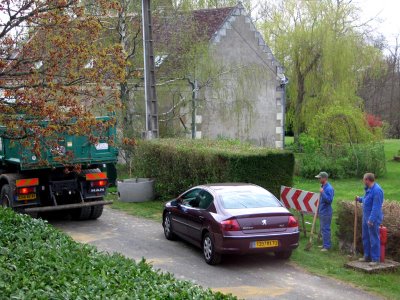 Our neighbor Jean-Michel in his new Peugeot 407 trying to get past
Our neighbor Jean-Michel in his new Peugeot 407 trying to get past
the dumptruck, the tractors, and the workers in their bleus de travail
Today we feel like we are jumping feet-first into the 20th century. Hey, does that mean Bush isn't president yet? Maybe it's not too late to prevent that catastrophe.
In April 2004 the village put in le tout-à-l'égout — French for sewer lines — along our road down the hill from us to serve the 12 or 15 houses down there. We and our neighbors in the eight houses on the upper stretch of the road were left sewerless. The mayor promised us that the sewer lines would be put in chez nous in 2005, and we started waiting and waiting started in April a year ago for something to happen. Despite the promises, there was no sign of construction work as 2005 drew to a close.
Well, the work finally started about 10 days ago. They have now laid the pipe along the 300 or 400 yards of road that go through the woods on the way up to our hameau (hamlet, or settlement). And today they are digging next to our house, along the road just outside our hedge. It's a mess, and it's inconvenient since we have a lot of visitors and guests right now. They will be digging up our little driveway in just a few minutes. But we can put up with it. Being hooked up to the sewers will significantly improve our lives.
Some of our neighbors have had septic systems for years, and they are not all happy about having to pay a contractor to come connect them to the new sewer lines. Others, us included, don't have septic systems. When we bought our house three years ago, we thought we did. But it turned out that what we had was a two-part system for disposing of waste water.
Our gray water — drainage from kitchen and bathroom sinks, the shower, washing machine, dishwasher and all — runs, along with rainwater collected by the roof gutters, down a long pipe buried under the gravel path that runs the length of our back yard. The eaux usées empty onto the ground on the edge of what passes for a dirt road along the back of our property. That system has worked pretty well for us these past three years. Only once did it get stopped up, and we had to have it unplugged by a company that blasted it out with a high-pressure water jet.
The waste from our WC goes into a sealed, underground holding tank that holds about 750 gallons (3000 liters). The tank fills up a little more every time somebody flushes the toilet. At the beginning, it would be full after two months. Then once, when we had heavy rains, it was full after one month. We realized rainwater was getting in. We didn't need to be paying to have rainwater pumped out and hauled away. We covered the whole area with a tarp, and then we found the tank filled up less quickly — every three or even four months.
When the tank is full, we have to call a company that specializes in pumping such tanks out and transporting the waste to a treatment plant. It costs us about $200 (175 euros) each time. That's bad enough. But the worst part is that there is no gauge on the tank. To see how full it is, you have to go poke a long stick into the tank and see how much room is left in there. As one woman working at the village hall said when I told her about our tank, "Ce n'est pas une solution très élégante" to the sewage problem.
 Our neighbor Jean-Michel in his new Peugeot 407 trying to get past
Our neighbor Jean-Michel in his new Peugeot 407 trying to get pastthe dumptruck, the tractors, and the workers in their bleus de travail
Today we feel like we are jumping feet-first into the 20th century. Hey, does that mean Bush isn't president yet? Maybe it's not too late to prevent that catastrophe.
16 April 2006
Chez un poissonnier, rue Montorgueil
March 31, a rainy day on the rue Montorgueil, a market street near Les Halles in Paris. The shops are all inviting because they are brightly lit, full of beautiful products, and a refuge from the steady rain. Here's a poissonnerie — a fish market. It's always fun to take pictures of the fish and shellfish, even if you don't intend to buy anything.
Rue Montorgueil is an extension of the rue Poissonnière, the old route that fish merchants took over the centuries from Dieppe and other fishing ports in Normandy to get to the central marketplace, Les Halles, in Paris. Les Halles was transferred to a site outside the city about 35 years ago, but several fish mongers maintain shops along the old route, which includes the rue Montorgueil.
One of the delicacies available in France but not in the U.S. is the variety of scallops called coquilles St-Jacques. In France, the orange roe in the shell is eaten along with the white muscle. In the U.S., the roe is either absent in our varieties of scallops, or it is thrown away in the cleaning process.
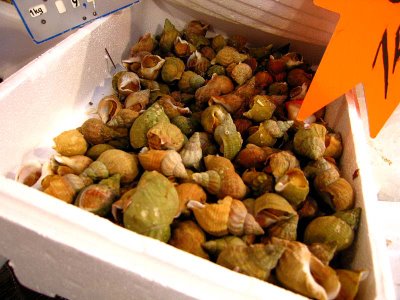
Another Norman specialty is the sea snails called bulots. They're sold cooked — steamed. You eat them by removing the animal from its shell with a pick or little fork. They are served cold with mayonnaise.
 These praires and palourdes are varieties of what we would call clams in the U.S.
These praires and palourdes are varieties of what we would call clams in the U.S.
It's interesting how cooking and food products have changed over the 35 years that I have been coming to France on a regular basis. For example, I have a book called La Cuisine du poisson by H.-P. Pellaprat (another book of his used to be commonly known as Le Pellaprat — I don't know if it is the same text). My copy is dated 2001, but I remember that a French friend had a copy back when I was in graduate shcool, in 1972 or '73. So the book has been around for a long time. This classic of French cookery has about 10 recipes for preparing coquilles St-Jacques, but not one for anything resembling clams, or even bulots. I think these were exclusively regional specialties until more recent years.
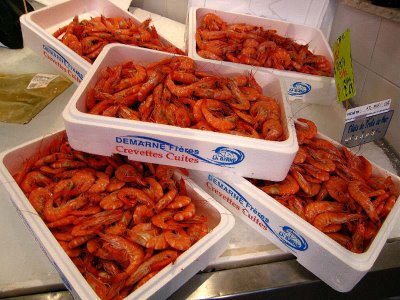 The Pellaprat also has no recipes for cooking shrimp (crevettes). One thing I miss here in France, in fact, is being able to buy uncooked shrimp (even frozen). They are hard to find, at least out here in the country, but cooked ones are plentiful. Here's my translation of what the Pellaprat has to say about crevettes:
The Pellaprat also has no recipes for cooking shrimp (crevettes). One thing I miss here in France, in fact, is being able to buy uncooked shrimp (even frozen). They are hard to find, at least out here in the country, but cooked ones are plentiful. Here's my translation of what the Pellaprat has to say about crevettes:
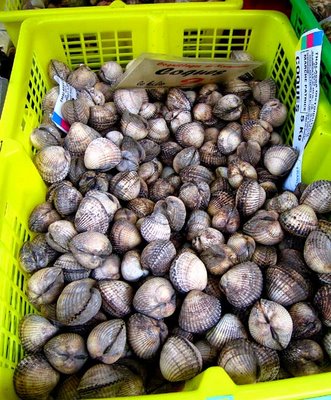 Here's something you don't see much in the U.S., as far as I know: cockles (coques). Again, there's no mention of them in the Pellaprat. The Larousse Gastronomique, another classic of French cooking, says cockles are called huîtres des pauvres — "the poor man's oyster". So you know what that means: buy oysters instead. Larousse also notes that they are eaten raw or prepared according the the methods used to cook mussels.
Here's something you don't see much in the U.S., as far as I know: cockles (coques). Again, there's no mention of them in the Pellaprat. The Larousse Gastronomique, another classic of French cooking, says cockles are called huîtres des pauvres — "the poor man's oyster". So you know what that means: buy oysters instead. Larousse also notes that they are eaten raw or prepared according the the methods used to cook mussels.
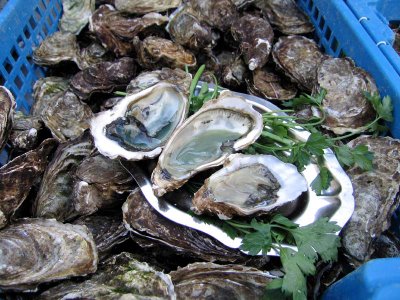 Speaking of oysters... they are plentiful in France. They are farmed in the cold waters of Normandy, Brittany, and down the Atlantic Coast to points south of Bordeaux. They are fattened in salt ponds along the shore before being gathered and taken to market.
Speaking of oysters... they are plentiful in France. They are farmed in the cold waters of Normandy, Brittany, and down the Atlantic Coast to points south of Bordeaux. They are fattened in salt ponds along the shore before being gathered and taken to market.
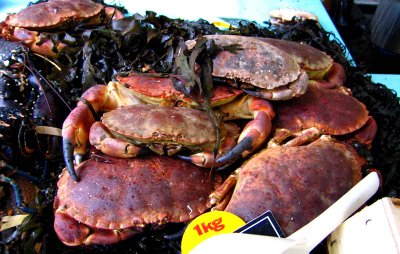 Stone crabs (tourteaux) are another standard item in French fish markets. The Larousse Gastronomique says:
Stone crabs (tourteaux) are another standard item in French fish markets. The Larousse Gastronomique says:
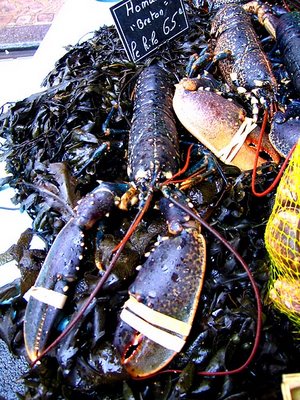 Obviously, it's better to buy a lobster (homard) if you can afford one. In France, they come from the waters off Brittany. Pellaprat gives nine recipes for homard and nine more for its cousin, la langouste or spiny lobster. The Larousse Gastronomique says that langouste is more digestible than homard, even though homard has better flavor and a firmer texture. The lobster in the picture above sells for 65 euros a kilo — that's nearly $40 a pound at current exchange rates.
Obviously, it's better to buy a lobster (homard) if you can afford one. In France, they come from the waters off Brittany. Pellaprat gives nine recipes for homard and nine more for its cousin, la langouste or spiny lobster. The Larousse Gastronomique says that langouste is more digestible than homard, even though homard has better flavor and a firmer texture. The lobster in the picture above sells for 65 euros a kilo — that's nearly $40 a pound at current exchange rates.
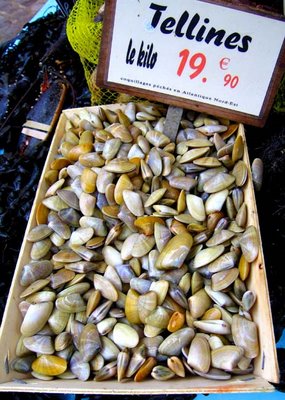 Tellines are a Mediterranean specialty, evidently. Neither Pellaprat nor Larousse mentions them. We have similar-looking bivalves along the southeast U.S. coast that we call coquina. In North Carolina, I've heard of people making coquina chowder or soup, but I've never known anybody who did. I suppose you could do the same with tellines in France, or you could follow this recipe.
Tellines are a Mediterranean specialty, evidently. Neither Pellaprat nor Larousse mentions them. We have similar-looking bivalves along the southeast U.S. coast that we call coquina. In North Carolina, I've heard of people making coquina chowder or soup, but I've never known anybody who did. I suppose you could do the same with tellines in France, or you could follow this recipe.
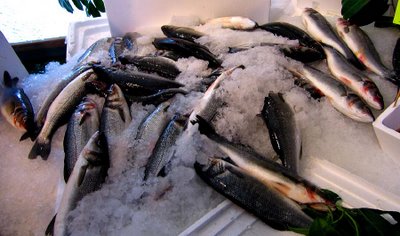 The poissoniers along the rue Montorgueil in Paris also sell fin fish, of course. These are salmons (saumons). They are probably farm-raised in Norway or Scotland.
The poissoniers along the rue Montorgueil in Paris also sell fin fish, of course. These are salmons (saumons). They are probably farm-raised in Norway or Scotland.
 These are mackerels (maquereaux). Fish in France is often cooked a served whole, head and all. I've never heard a French person complain about the fish looking back at you while you're eating it, but I've heard that complaint from more than a few Americans.
These are mackerels (maquereaux). Fish in France is often cooked a served whole, head and all. I've never heard a French person complain about the fish looking back at you while you're eating it, but I've heard that complaint from more than a few Americans.
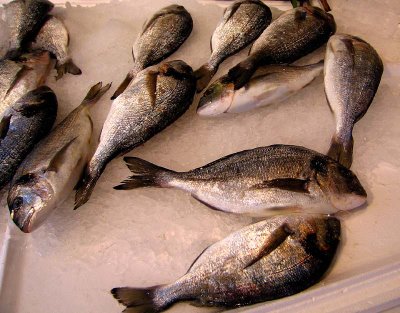 I think these are called dorades, or dorado in English(!). It's hard to know what fish in France corresponds to what fish in the U.S., because the names are often locally specific in each country. These dorades look a little like what we called hogfish when I was growing up in North Carolina. We caught, cleaned, cooked, and ate them often.
I think these are called dorades, or dorado in English(!). It's hard to know what fish in France corresponds to what fish in the U.S., because the names are often locally specific in each country. These dorades look a little like what we called hogfish when I was growing up in North Carolina. We caught, cleaned, cooked, and ate them often.
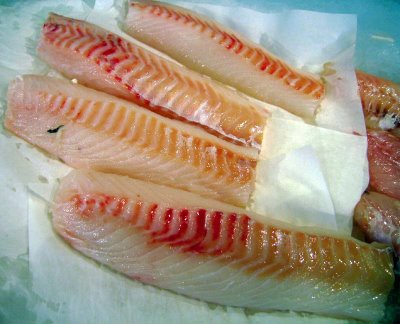 It seems that most people prefer fish filets. Most serious cooks will tell you, however, that cooking fish on the bone — and meat too, for that matter — give a more flavorful result. I read recently that American restaurant customers want to be served boneless meat and fish more than ever nowadays. They don't want to have anything left on the plate when they finish eating. To me, that's just another step in the evolution that has separated Americans from their food sources and opened the door to more processed, pre-cooked foods (including fast food) rather than real cooking. That's my two cents.
It seems that most people prefer fish filets. Most serious cooks will tell you, however, that cooking fish on the bone — and meat too, for that matter — give a more flavorful result. I read recently that American restaurant customers want to be served boneless meat and fish more than ever nowadays. They don't want to have anything left on the plate when they finish eating. To me, that's just another step in the evolution that has separated Americans from their food sources and opened the door to more processed, pre-cooked foods (including fast food) rather than real cooking. That's my two cents.
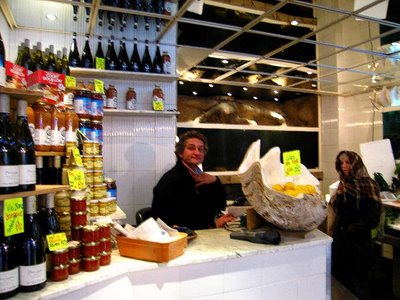 After I had taken a picture or two in the fish market on Montorgueil, I realized I should have asked permission. I did, and the man at the desk said he didn't mind as long as I took his picture too. So I snapped his portrait. Here he is with a customer.
After I had taken a picture or two in the fish market on Montorgueil, I realized I should have asked permission. I did, and the man at the desk said he didn't mind as long as I took his picture too. So I snapped his portrait. Here he is with a customer.
Rue Montorgueil is an extension of the rue Poissonnière, the old route that fish merchants took over the centuries from Dieppe and other fishing ports in Normandy to get to the central marketplace, Les Halles, in Paris. Les Halles was transferred to a site outside the city about 35 years ago, but several fish mongers maintain shops along the old route, which includes the rue Montorgueil.
One of the delicacies available in France but not in the U.S. is the variety of scallops called coquilles St-Jacques. In France, the orange roe in the shell is eaten along with the white muscle. In the U.S., the roe is either absent in our varieties of scallops, or it is thrown away in the cleaning process.

Another Norman specialty is the sea snails called bulots. They're sold cooked — steamed. You eat them by removing the animal from its shell with a pick or little fork. They are served cold with mayonnaise.
 These praires and palourdes are varieties of what we would call clams in the U.S.
These praires and palourdes are varieties of what we would call clams in the U.S.It's interesting how cooking and food products have changed over the 35 years that I have been coming to France on a regular basis. For example, I have a book called La Cuisine du poisson by H.-P. Pellaprat (another book of his used to be commonly known as Le Pellaprat — I don't know if it is the same text). My copy is dated 2001, but I remember that a French friend had a copy back when I was in graduate shcool, in 1972 or '73. So the book has been around for a long time. This classic of French cookery has about 10 recipes for preparing coquilles St-Jacques, but not one for anything resembling clams, or even bulots. I think these were exclusively regional specialties until more recent years.
 The Pellaprat also has no recipes for cooking shrimp (crevettes). One thing I miss here in France, in fact, is being able to buy uncooked shrimp (even frozen). They are hard to find, at least out here in the country, but cooked ones are plentiful. Here's my translation of what the Pellaprat has to say about crevettes:
The Pellaprat also has no recipes for cooking shrimp (crevettes). One thing I miss here in France, in fact, is being able to buy uncooked shrimp (even frozen). They are hard to find, at least out here in the country, but cooked ones are plentiful. Here's my translation of what the Pellaprat has to say about crevettes:Crevettes are most often enjoyed just as they are as an hors-d'œuvre, but one can also serve them hot, either in pastry or tart shells, or in clam shells, with an appropriate sauce and mixed as desired with mushrooms or fish dumplings, which cut the shrimps' saltiness. I only mention this in passing, because the mistress of the house won't often need to prepare such dishes.
 Here's something you don't see much in the U.S., as far as I know: cockles (coques). Again, there's no mention of them in the Pellaprat. The Larousse Gastronomique, another classic of French cooking, says cockles are called huîtres des pauvres — "the poor man's oyster". So you know what that means: buy oysters instead. Larousse also notes that they are eaten raw or prepared according the the methods used to cook mussels.
Here's something you don't see much in the U.S., as far as I know: cockles (coques). Again, there's no mention of them in the Pellaprat. The Larousse Gastronomique, another classic of French cooking, says cockles are called huîtres des pauvres — "the poor man's oyster". So you know what that means: buy oysters instead. Larousse also notes that they are eaten raw or prepared according the the methods used to cook mussels. Speaking of oysters... they are plentiful in France. They are farmed in the cold waters of Normandy, Brittany, and down the Atlantic Coast to points south of Bordeaux. They are fattened in salt ponds along the shore before being gathered and taken to market.
Speaking of oysters... they are plentiful in France. They are farmed in the cold waters of Normandy, Brittany, and down the Atlantic Coast to points south of Bordeaux. They are fattened in salt ponds along the shore before being gathered and taken to market. Stone crabs (tourteaux) are another standard item in French fish markets. The Larousse Gastronomique says:
Stone crabs (tourteaux) are another standard item in French fish markets. The Larousse Gastronomique says:Culinarily, crabs can be prepared according to all the methods used to cook lobsters. It is appropriate, however, to point out that even the largest crab contains only a small quantity of edible flesh. But the liver of these crustaceans is fairly large, and eaten with the creamy substance that surrounds it, it is full of flavor. Along with the claw meat, that's about all that is edible in a crab.Not a ringing endorsement, I'd say. Pellaprat is a little more generous, and gives five recipes.
 Obviously, it's better to buy a lobster (homard) if you can afford one. In France, they come from the waters off Brittany. Pellaprat gives nine recipes for homard and nine more for its cousin, la langouste or spiny lobster. The Larousse Gastronomique says that langouste is more digestible than homard, even though homard has better flavor and a firmer texture. The lobster in the picture above sells for 65 euros a kilo — that's nearly $40 a pound at current exchange rates.
Obviously, it's better to buy a lobster (homard) if you can afford one. In France, they come from the waters off Brittany. Pellaprat gives nine recipes for homard and nine more for its cousin, la langouste or spiny lobster. The Larousse Gastronomique says that langouste is more digestible than homard, even though homard has better flavor and a firmer texture. The lobster in the picture above sells for 65 euros a kilo — that's nearly $40 a pound at current exchange rates. Tellines are a Mediterranean specialty, evidently. Neither Pellaprat nor Larousse mentions them. We have similar-looking bivalves along the southeast U.S. coast that we call coquina. In North Carolina, I've heard of people making coquina chowder or soup, but I've never known anybody who did. I suppose you could do the same with tellines in France, or you could follow this recipe.
Tellines are a Mediterranean specialty, evidently. Neither Pellaprat nor Larousse mentions them. We have similar-looking bivalves along the southeast U.S. coast that we call coquina. In North Carolina, I've heard of people making coquina chowder or soup, but I've never known anybody who did. I suppose you could do the same with tellines in France, or you could follow this recipe. The poissoniers along the rue Montorgueil in Paris also sell fin fish, of course. These are salmons (saumons). They are probably farm-raised in Norway or Scotland.
The poissoniers along the rue Montorgueil in Paris also sell fin fish, of course. These are salmons (saumons). They are probably farm-raised in Norway or Scotland. These are mackerels (maquereaux). Fish in France is often cooked a served whole, head and all. I've never heard a French person complain about the fish looking back at you while you're eating it, but I've heard that complaint from more than a few Americans.
These are mackerels (maquereaux). Fish in France is often cooked a served whole, head and all. I've never heard a French person complain about the fish looking back at you while you're eating it, but I've heard that complaint from more than a few Americans. I think these are called dorades, or dorado in English(!). It's hard to know what fish in France corresponds to what fish in the U.S., because the names are often locally specific in each country. These dorades look a little like what we called hogfish when I was growing up in North Carolina. We caught, cleaned, cooked, and ate them often.
I think these are called dorades, or dorado in English(!). It's hard to know what fish in France corresponds to what fish in the U.S., because the names are often locally specific in each country. These dorades look a little like what we called hogfish when I was growing up in North Carolina. We caught, cleaned, cooked, and ate them often. It seems that most people prefer fish filets. Most serious cooks will tell you, however, that cooking fish on the bone — and meat too, for that matter — give a more flavorful result. I read recently that American restaurant customers want to be served boneless meat and fish more than ever nowadays. They don't want to have anything left on the plate when they finish eating. To me, that's just another step in the evolution that has separated Americans from their food sources and opened the door to more processed, pre-cooked foods (including fast food) rather than real cooking. That's my two cents.
It seems that most people prefer fish filets. Most serious cooks will tell you, however, that cooking fish on the bone — and meat too, for that matter — give a more flavorful result. I read recently that American restaurant customers want to be served boneless meat and fish more than ever nowadays. They don't want to have anything left on the plate when they finish eating. To me, that's just another step in the evolution that has separated Americans from their food sources and opened the door to more processed, pre-cooked foods (including fast food) rather than real cooking. That's my two cents. After I had taken a picture or two in the fish market on Montorgueil, I realized I should have asked permission. I did, and the man at the desk said he didn't mind as long as I took his picture too. So I snapped his portrait. Here he is with a customer.
After I had taken a picture or two in the fish market on Montorgueil, I realized I should have asked permission. I did, and the man at the desk said he didn't mind as long as I took his picture too. So I snapped his portrait. Here he is with a customer.15 April 2006
Shopping around Les Halles and rue Montorgueil
The apartment we rented for our recent Paris trip wasn't too far from the rue Montorgueil. We ended up walking through that street several times over the course of the week. Back in 1979-82, I lived in the neighborhood, in a 6th floor walk-up apartment on the rue St-Sauveur, just a few steps off the street shown in this picture.
The rue Montorgueil was turned into a pedestrian mall about 15 years ago, and a lot of the old businesses, mostly food shops, have been turned into restaurants and cafés now. But quite a few of the fromageries, poissonneries, boucheries, and boulangeries are still there. Even on a rainy gray day the atmosphere is busy and colorful.
One of the oldest shops on the street is the Pâtisserie Stohrer, which has been there since the early 1700s. Here are a couple of pictures.
Not too far away from the rue Montorgueil is the Dehillerin kitchen shop. I posted a picture of the storefront earlier. Here are a couple of photos I took inside the store.
Another Les Halles kitchen shop, nearby on the rue Etienne-Marcel, is La Bovida. It's also worth a visit.
The rue Montorgueil was turned into a pedestrian mall about 15 years ago, and a lot of the old businesses, mostly food shops, have been turned into restaurants and cafés now. But quite a few of the fromageries, poissonneries, boucheries, and boulangeries are still there. Even on a rainy gray day the atmosphere is busy and colorful.
One of the oldest shops on the street is the Pâtisserie Stohrer, which has been there since the early 1700s. Here are a couple of pictures.
Not too far away from the rue Montorgueil is the Dehillerin kitchen shop. I posted a picture of the storefront earlier. Here are a couple of photos I took inside the store.
Another Les Halles kitchen shop, nearby on the rue Etienne-Marcel, is La Bovida. It's also worth a visit.
13 April 2006
Walks in Paris
Yesterday I started a new photo blog (Ken's Photo Album: Loire Valley images) here so that I can post even more pictures every day. In the sidebar on the left, I've also added some links to other blogs I enjoy keeping up with.
The week in Paris is fading into the past already. And it has been a month since Collette died, already. Here are some pictures I took on our long walks around Paris on April 1 and 2.
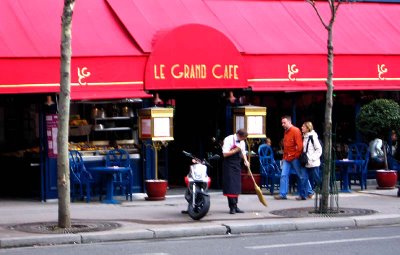 On the Grands Boulevards on a Saturday morning, people working in the cafés and restaurants were setting up and cleaning up in preparation for the busy weekend.
On the Grands Boulevards on a Saturday morning, people working in the cafés and restaurants were setting up and cleaning up in preparation for the busy weekend.
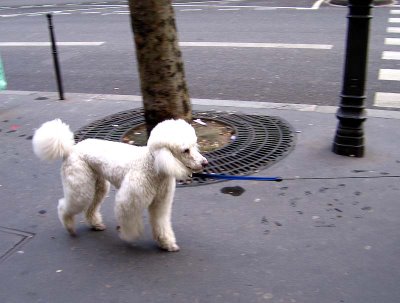 This white poodle was out for a walk near the Opéra. He (or she) looks as if he had a visit to the coiffeur on Friday so he would look good for the weekend.
This white poodle was out for a walk near the Opéra. He (or she) looks as if he had a visit to the coiffeur on Friday so he would look good for the weekend.
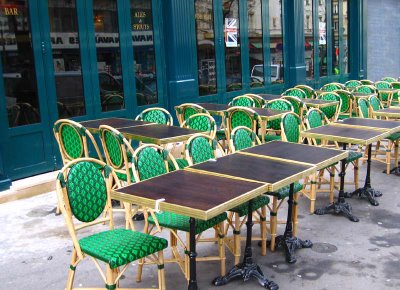 Obviously, the crowds hadn't arrived yet. But everything was ready for them. April in Paris: you have to be optimistic and hope for warm, sunny weather. But don't count on it.
Obviously, the crowds hadn't arrived yet. But everything was ready for them. April in Paris: you have to be optimistic and hope for warm, sunny weather. But don't count on it.
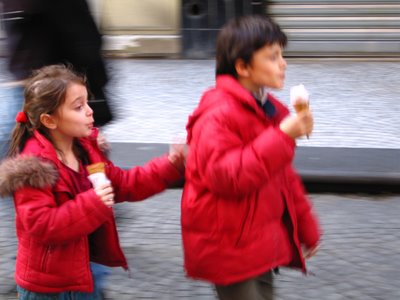 On the rue Montorgueil, these two kids, clearly sister and brother, had their ice cream cones and were out for a walk. They appeared to be happy and comfortable in the crowded street, and they carried on a cheerful conversation as they strolled.
On the rue Montorgueil, these two kids, clearly sister and brother, had their ice cream cones and were out for a walk. They appeared to be happy and comfortable in the crowded street, and they carried on a cheerful conversation as they strolled.
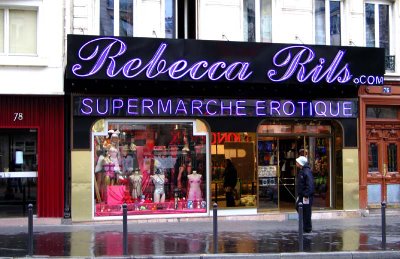 Over near the Place Clichy, the supermarkets were open for business. I imagine this one is open 24 hours a day, and it probably does its best business after dark.
Over near the Place Clichy, the supermarkets were open for business. I imagine this one is open 24 hours a day, and it probably does its best business after dark.
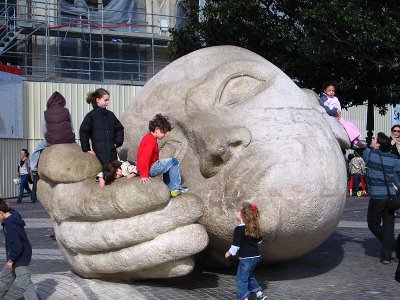 At Les Halles, near the Eglise St-Eustache, kids were playing on this street-art sculpture. It's easy to lose your head in Paris, I guess.
At Les Halles, near the Eglise St-Eustache, kids were playing on this street-art sculpture. It's easy to lose your head in Paris, I guess.
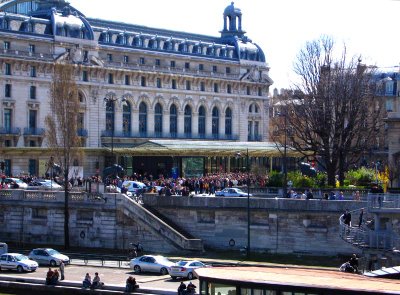 The crowd waiting to get into the Musée d'Orsay on a Sunday afternoon is enough to make me wait for another day to visit the place. Maybe a rainy day...
The crowd waiting to get into the Musée d'Orsay on a Sunday afternoon is enough to make me wait for another day to visit the place. Maybe a rainy day...
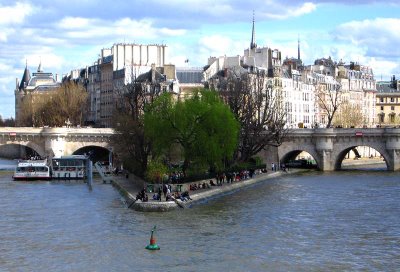 There was also a pretty good crowd down by the Seine around the Square du Vert-Galant, at the tip of the Ile de la Cité. It was a bright sunny Sunday afternoon.
There was also a pretty good crowd down by the Seine around the Square du Vert-Galant, at the tip of the Ile de la Cité. It was a bright sunny Sunday afternoon.
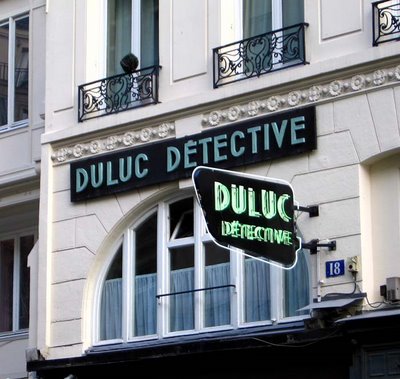 Finally, if anybody is missing, or you think somebody's up to no good, you can always engage the services of Monsieur Duluc, a private eye whose offices are on the rue du Louvre near the rue de Rivoli. His sign has been at the same spot for many many years, so he must do good work.
Finally, if anybody is missing, or you think somebody's up to no good, you can always engage the services of Monsieur Duluc, a private eye whose offices are on the rue du Louvre near the rue de Rivoli. His sign has been at the same spot for many many years, so he must do good work.
* * *
The week in Paris is fading into the past already. And it has been a month since Collette died, already. Here are some pictures I took on our long walks around Paris on April 1 and 2.
 On the Grands Boulevards on a Saturday morning, people working in the cafés and restaurants were setting up and cleaning up in preparation for the busy weekend.
On the Grands Boulevards on a Saturday morning, people working in the cafés and restaurants were setting up and cleaning up in preparation for the busy weekend. This white poodle was out for a walk near the Opéra. He (or she) looks as if he had a visit to the coiffeur on Friday so he would look good for the weekend.
This white poodle was out for a walk near the Opéra. He (or she) looks as if he had a visit to the coiffeur on Friday so he would look good for the weekend. Obviously, the crowds hadn't arrived yet. But everything was ready for them. April in Paris: you have to be optimistic and hope for warm, sunny weather. But don't count on it.
Obviously, the crowds hadn't arrived yet. But everything was ready for them. April in Paris: you have to be optimistic and hope for warm, sunny weather. But don't count on it. On the rue Montorgueil, these two kids, clearly sister and brother, had their ice cream cones and were out for a walk. They appeared to be happy and comfortable in the crowded street, and they carried on a cheerful conversation as they strolled.
On the rue Montorgueil, these two kids, clearly sister and brother, had their ice cream cones and were out for a walk. They appeared to be happy and comfortable in the crowded street, and they carried on a cheerful conversation as they strolled. Over near the Place Clichy, the supermarkets were open for business. I imagine this one is open 24 hours a day, and it probably does its best business after dark.
Over near the Place Clichy, the supermarkets were open for business. I imagine this one is open 24 hours a day, and it probably does its best business after dark. At Les Halles, near the Eglise St-Eustache, kids were playing on this street-art sculpture. It's easy to lose your head in Paris, I guess.
At Les Halles, near the Eglise St-Eustache, kids were playing on this street-art sculpture. It's easy to lose your head in Paris, I guess. The crowd waiting to get into the Musée d'Orsay on a Sunday afternoon is enough to make me wait for another day to visit the place. Maybe a rainy day...
The crowd waiting to get into the Musée d'Orsay on a Sunday afternoon is enough to make me wait for another day to visit the place. Maybe a rainy day... There was also a pretty good crowd down by the Seine around the Square du Vert-Galant, at the tip of the Ile de la Cité. It was a bright sunny Sunday afternoon.
There was also a pretty good crowd down by the Seine around the Square du Vert-Galant, at the tip of the Ile de la Cité. It was a bright sunny Sunday afternoon. Finally, if anybody is missing, or you think somebody's up to no good, you can always engage the services of Monsieur Duluc, a private eye whose offices are on the rue du Louvre near the rue de Rivoli. His sign has been at the same spot for many many years, so he must do good work.
Finally, if anybody is missing, or you think somebody's up to no good, you can always engage the services of Monsieur Duluc, a private eye whose offices are on the rue du Louvre near the rue de Rivoli. His sign has been at the same spot for many many years, so he must do good work.
Subscribe to:
Posts (Atom)


